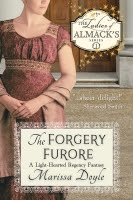I know some of you are.
At the very bottom layer, she’d have worn a chemise, like a loose nightgown of cotton or linen, going to about the knee. Some of the most daring young ladies omitted this so that their gowns would drape better. Next she’d wear a bodiced petticoat of cotton, cambric, or linen, although some wore flannel ones in the winter in some areas. As Marissa mentioned, later in the century the more petticoats, the better. Drawers (think cotton board shorts with draw strings at the waist and at the knee openings) were just coming into fashion and considered rather shocking.
Ask me sometime how they actually went to the bathroom in all this.
 Over all this (yes over, not under) she wore a corset, also called stays. It probably didn’t have bones in the seams yet, but there would be a busk (a length of wood, ivory, or whale bone about the size of a ruler) separating her breasts. You had to have good posture wearing a corset. And, contrary to numerous films, it didn’t lace up tight like a shoe. The single string wound back and forth like a sewing needle through eyes in the stiff fabric, pulling the two sides together. There are a very few examples of stays that cross over the breasts and fasten in front. I imagine those would have been very welcome for the young lady forced to live with her father and brothers and no maid!
Over all this (yes over, not under) she wore a corset, also called stays. It probably didn’t have bones in the seams yet, but there would be a busk (a length of wood, ivory, or whale bone about the size of a ruler) separating her breasts. You had to have good posture wearing a corset. And, contrary to numerous films, it didn’t lace up tight like a shoe. The single string wound back and forth like a sewing needle through eyes in the stiff fabric, pulling the two sides together. There are a very few examples of stays that cross over the breasts and fasten in front. I imagine those would have been very welcome for the young lady forced to live with her father and brothers and no maid!As Marissa mentioned in response to a comment on Tuesday’s post, they’d also be wearing knee-high silk or perhaps wool stockings held up by garters. Earlier young ladies also wore pockets under their clothes. These were fabric pouches on a ribbon that tied around your waist. Because so many of the fashionable fabrics were now sheer, pockets would have been visible, so they were considered quite passé. The idea of those sheer fabrics was to hint at the curves of the female form. There are also distressing rumors that some young ladies actually dampened their petticoats with water to allow the fabrics to cling even more.
Thinking of those cool, damp winters in England, all I can say is brrrr.





2 comments:
You're very welcome! If you have other suggestions for posts, please let us know.
"Ask me sometime how they actually went to the bathroom in all this."
I've read that drawers were actually crotchless, so all a lady had to do was lift her skirt. Panties as we know them were not widely adopted until the 1930s.
Post a Comment